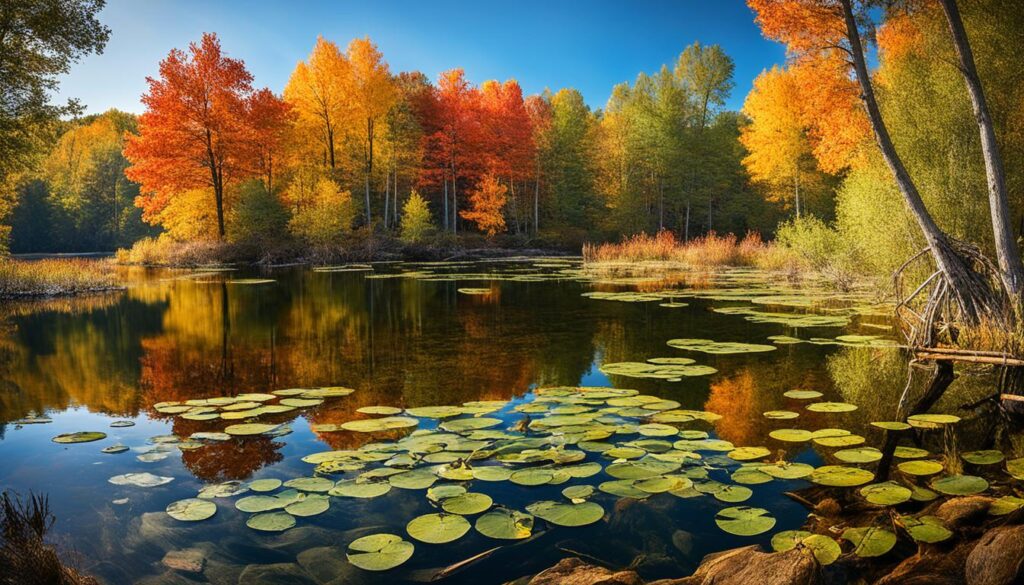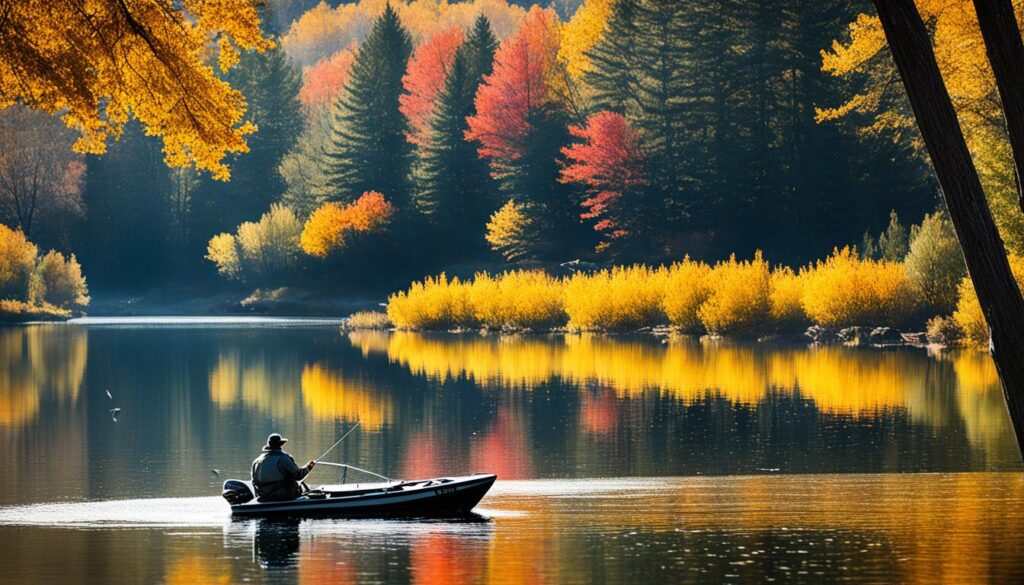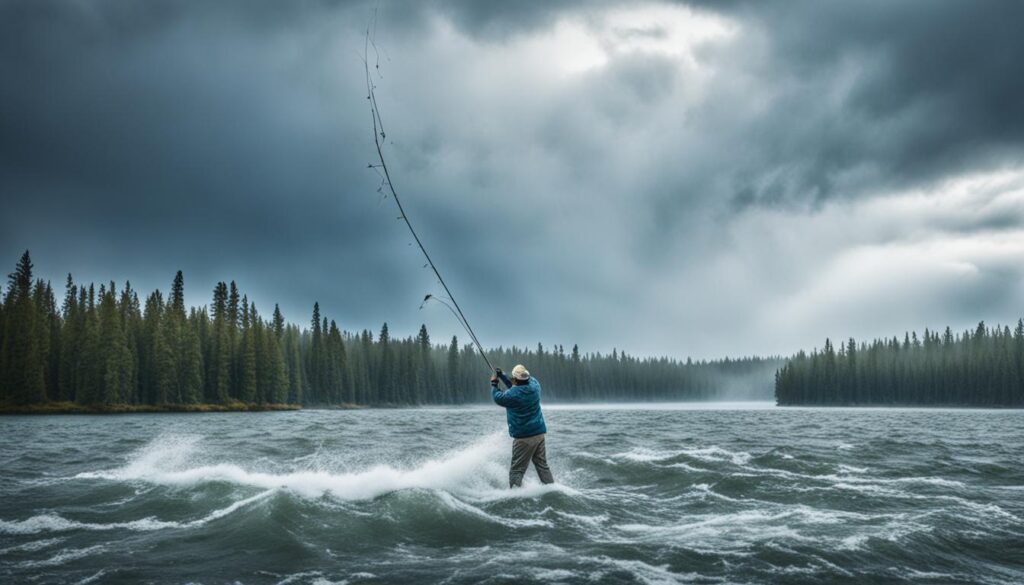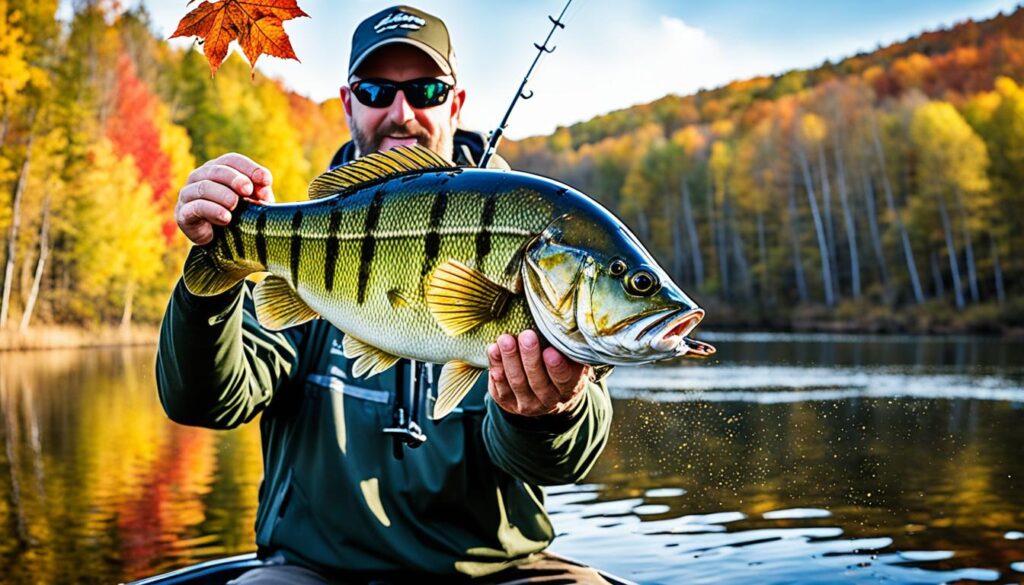Fall is a fantastic time for bass fishing, and if you want to take your angling skills to the next level, it’s essential to have the right tactics in your arsenal. Fortunately, I’ve gathered expert advice from some of the best anglers in the industry to help you master fall bass fishing and increase your chances of success during this season.
Whether you’re a seasoned pro or just starting out, these professional tips will provide you with the knowledge and strategies you need to maximize your fishing experience. From targeting specific environments to adapting your techniques based on changing conditions, these tactics will give you a competitive edge when it comes to fall bass fishing.
In this article, we’ll explore the best fall bass fishing techniques, expert insights, and top tips for autumn bass fishing. By incorporating these strategies into your approach, you’ll be well-equipped to navigate the challenges of fall bass fishing and increase your chances of landing that trophy catch.
Key Takeaways
- Master the art of fall bass fishing with these pro tips.
- Adapt your techniques based on the season and changing conditions.
- Target specific areas and environments favored by bass during the fall.
- Pay attention to water clarity and adjust lure colors and actions accordingly.
- Cover water quickly to locate active fish and eliminate dead spots.
Go Shallow and Follow Baitfish
When it comes to fall bass fishing, going shallow can make a significant difference in your success. Pro angler Bill McDonald recommends targeting skinny water, especially during a full moon, to increase your chances of hooking into bass.
Largemouth and smallmouth bass have a natural instinct to follow baitfish, and they often venture into overlooked shallow areas. By focusing your efforts in these locations, you can take advantage of this behavior and improve your catch rate during the fall season.
Going shallow allows you to capitalize on the bass’s feeding patterns as they hunt for baitfish. These areas provide ample opportunities for ambush strikes and enticing topwater action. It’s crucial to keep a close eye on the movements of baitfish, as the activity can give you valuable insights into where the bass are likely to be.
To maximize your success, consider using lures that imitate baitfish and can effectively target the shallow areas. Topwater lures such as buzzbaits and poppers can generate explosive strikes when worked over submerged vegetation or near shoreline structures. Crankbaits and spinnerbaits can also be productive in these shallow areas as they mimic the movements of baitfish, triggering reaction bites from hungry bass.
Remember, going shallow and following baitfish is a proven tactic for fall bass fishing, and incorporating it into your angling strategy can lead to exciting and rewarding experiences on the water.
Target the “False Spawn”
When it comes to fall bass fishing in the Great Lakes, targeting the “false spawn” can be a game-changer. Pro angler Mark Zona recommends focusing on this unique phenomenon, which occurs when water temperatures hover around the low 60s. During this period, big male smallmouth bass transition onto shallow spawning flats and re-occupy old beds, creating excellent opportunities for anglers.
The “false spawn” typically takes place between September and October, with the full moon period being the most favorable time. By understanding this natural behavior, anglers can strategically position themselves in known shallow flats, increasing their chances of landing some impressive smallmouth bass during the fall season.
To help you visualize the false spawn phenomenon and its effect on the fall bass fishing, here is a diagram:

During the false spawn, smallmouth bass move onto the shallow flats, following their natural spawning instincts. This behavior allows anglers to target these aggressive males in relatively shallow waters, where they can present their baits with precision and entice strikes.
“The false spawn is a remarkable time to target fall Great Lakes smallmouth bass. It’s when these fish can be found in high numbers in shallow waters, staging for their upcoming spawning period. It’s an exciting time for bass fishing enthusiasts.” – Mark Zona
By taking advantage of the false spawn, anglers can experience thrilling moments on the water while reeling in some impressive smallmouth bass. It’s essential to monitor water temperatures and plan your fishing trips accordingly to maximize your chances of success during this period.
Fish the Featureless Areas
When it comes to fall bass fishing, targeting featureless areas in the water can be a winning strategy. Mark Rose, an experienced angler, suggests focusing on nondescript pockets, creek arms, and bays in order to find largemouth bass. These areas often attract large schools of shad, which can be effectively targeted using moving baits such as crankbaits. By exploring the seemingly unremarkable spots, you may discover hidden hotspots teeming with fish.
To gain a better understanding of this tactic, imagine yourself adrift in a vast lake, scattered with narrow creeks and expansive bays. Rather than getting drawn to the more obvious structures like docks or fallen trees, set your sights on the less conspicuous areas that might easily be overlooked. These featureless sections often hold an abundance of bass, presenting a golden opportunity for anglers looking to reel in a big catch. It’s all about staying nimble and venturing beyond the beaten path in search of those hidden gems.
Exploring Nondescript Pockets
Nondescript pockets are small, unremarkable indentations in the shoreline or body of water. While they may seem insignificant at first glance, these pockets can be bass magnets. Bass often use these areas to ambush prey, making them ideal feeding grounds during the fall season. To maximize your chances of success, consider utilizing moving baits like crankbaits. These lures mimic wounded baitfish, enticing bass to strike.
Cracking the Code in Creek Arms
Creek arms, as their name suggests, are narrow passages that extend from the main body of a creek. These areas often host a plentiful supply of food for largemouth bass, making them prime fishing spots during the fall. By analyzing the conditions and understanding the bass’s behavior, you can identify the key locations within the creek arms where the fish are most likely to congregate.
During the autumn season, bass commonly position themselves in the mouth of the creek arms, waiting for unsuspecting prey to pass through. They take advantage of the influx of shad and other baitfish entering these areas. To target these bass effectively, try using moving baits that mimic the action and appearance of shad or other baitfish species. This technique can trick the bass into striking, leading to an exhilarating fight.
Capitalizing on Bays
Bays are large, shallow areas found along the shoreline or within a body of water. While they may not be visually impressive, bays can be buzzing with activity, especially during the fall. Baitfish often seek refuge in bays during this time, providing an abundant food source for largemouth bass.
In order to exploit the potential of bays, focus on covering water quickly. Utilize moving baits like crankbaits or other lures that imitate the movement of the baitfish. The goal is to mimic the injured or vulnerable prey, triggering an instinctual response from the bass. By keeping your presentation dynamic and exploring a variety of areas within the bay, you can increase your chances of landing the prized catch.
| Pros of Fishing Featureless Areas | Cons of Fishing Featureless Areas |
|---|---|
|
|
Remember, exploring and fishing featureless areas requires adaptability, persistence, and a willingness to stray from the conventional path. While it may involve some trial and error initially, the rewards can be well worth the effort. So, grab your tackle box, head out to the water, and venture into the unknown to discover the treasures hidden amidst the seemingly ordinary.
Find the Food
When it comes to fall bass fishing, one of the most crucial factors for success is finding the food. Bass are known to school heavily during this season, actively feeding on baitfish like shad and bluegills. To maximize your chances of hooking into a trophy bass, it’s essential to locate areas where these bass schools are actively feeding.
Mark Davis, an experienced angler, emphasizes the importance of finding the feeding grounds. Bass will often follow the baitfish, so keep an eye out for any signs of activity such as surface disturbances or birds diving into the water. If you’re not seeing any food-related action, it’s best to move on and search for other areas where bass are more active.
“The key to fall bass fishing is understanding their feeding patterns. By finding the food, you can position yourself in the right place at the right time to catch those hungry bass.”
When searching for feeding grounds, pay attention to underwater structures, drop-offs, and points that are likely to attract baitfish. These locations can act as hotspots for bass as they wait to ambush their prey. Casting your bait around these areas and using techniques that mimic the movements of the baitfish can prove highly effective.
Common Baitfish Species
| Baitfish Species | Characteristics |
|---|---|
| Shad | Small, silvery fish found in freshwater rivers and lakes |
| Bluegills | Small, round fish with blue-green scales and a black operculum |
Understanding the baitfish species that bass are targeting during the fall can also help you select the right lures and presentation techniques. Shad and bluegills, in particular, are common prey for bass, so using lures that imitate their appearance and behavior can greatly increase your chances of attracting strikes.
So remember, when you’re out on the water during the fall season, don’t forget to find the food. By locating the areas where bass are actively feeding on baitfish, you’ll significantly improve your chances of catching trophy bass and having a successful fall bass fishing adventure.

Utilize Windblown Structures
When it comes to fall bass fishing, one tactic that can greatly improve your chances of success is targeting windblown structures. Pro angler Mark Menendez recommends utilizing these structures, particularly those that experience current. By fishing with the wind at your back, you can cover water quickly and focus on areas such as corners of points and channel swings.
Bass are known to position themselves facing into the current, taking advantage of the water flow to ambush prey. This makes windblown structures prime locations for finding actively feeding bass during the fall season. To entice these hungry fish, Menendez suggests using a fast-moving spinnerbait.
Spinnerbaits are effective lures for fall bass fishing as they mimic baitfish with their spinning blades and vibrant skirts. The flash and vibration created by the spinnerbait can trigger aggressive strikes from bass on windblown structures.

To increase your hook-up ratio, consider adding a trailer hook to your spinnerbait. This additional hook increases the chances of connecting with short-striking fish, ensuring that you don’t miss out on any opportunities. By leveraging windblown structures, currents, and the strategic use of spinnerbaits, you can optimize your fall bass fishing experience and increase your chances of landing that trophy catch.
Simplify Your Tackle Selection
When it comes to fall bass fishing, simplicity can be the key to success. Pro angler Boyd Duckett recommends streamlining your tackle selection and focusing on specific presentations that cover a range of fall bass fishing scenarios. By doing so, you can maximize your effectiveness on the water and increase your chances of landing that trophy bass.
Simplify and Succeed
Carrying an overloaded tackle box can be overwhelming and counterproductive. Instead, opt for a simplified approach that allows you to quickly adapt to changing conditions and target bass effectively. Here are the five specific presentations Boyd Duckett recommends for fall bass fishing:
- Crankbaits: These versatile lures are perfect for covering water and imitating baitfish. Choose different sizes and colors to match the forage in your area.
- Jerkbaits: Jerkbaits excel in cooler water temperatures and can entice reaction strikes from bass. Experiment with different retrieves to find the most effective cadence.
- Swimbaits: If you’re targeting larger bass, swimbaits can be an excellent choice. These lifelike lures mimic injured baitfish and can trigger predatory instincts.
- Topwaters: Nothing beats the explosive action of a topwater strike. Keep a variety of topwater lures, such as poppers and walking baits, to capitalize on aggressive feeding behavior.
- Lipless Crankbaits: When bass are feeding on shad or other baitfish, a lipless crankbait can be deadly. The fast, vibrating action can trigger reaction strikes even in challenging conditions.
By simplifying your tackle selection to these specific presentations, you’ll be equipped to handle various fall bass fishing situations and increase your chances of success out on the water.
Adjust Your Techniques Based on Water Clarity
When it comes to fall bass fishing, adjusting your techniques based on water clarity can significantly improve your chances of success. Pro angler Boyd Duckett suggests adapting your approach to effectively target bass in different water conditions. By understanding how water clarity impacts bass behavior, you can tailor your strategies accordingly.
In stained water, where visibility is limited, targeting shallow flats is essential. Bass often take refuge in these areas, which provide cover and ambush points. To entice bass in stained water, try using a Yamamoto Chikara 100 Series squarebill crankbait. This lure’s compact size and aggressive action can trigger reaction strikes even in low visibility.
However, if you find yourself fishing in moderately clear water, you’ll need to adjust your techniques accordingly. In this scenario, bass may be more cautious and require a subtler presentation. Switching to the Yamamoto Chikara 200 Series squarebill crankbait can be more effective. This lure’s wider wobble and more natural action mimic the movements of baitfish, enticing bass in clearer water to strike.
By adapting your approach to water clarity and selecting the right lures for each situation, you can maximize your chances of landing bass during the fall season.
| Water Clarity | Technique | Lure Recommendation |
|---|---|---|
| Stained | Target shallow flats | Yamamoto Chikara 100 Series squarebill crankbait |
| Moderately clear | Adjust your presentation | Yamamoto Chikara 200 Series squarebill crankbait |
Cover Water Quickly and Eliminate Dead Spots
When it comes to fall bass fishing, one of the key strategies is to cover water quickly and eliminate dead spots. By using your trolling motor on a high setting, you can efficiently move through different areas of the water and locate active fish. The goal is to find a school of bass that is worth making multiple casts to, increasing your chances of hooking into them.
By covering water quickly, you are able to explore different sections of the lake or river, increasing your chances of finding the hot spots where bass are congregating. This technique is especially useful during the fall season when bass are on the move and actively feeding.
As you navigate the water, keep an eye out for signs of activity such as busting baitfish or surface disturbances. These are indicators that bass are nearby and actively feeding. By eliminating dead spots and focusing on areas with high fish activity, you can maximize your chances of success.
Remember to make multiple casts to each promising spot before moving on. In many cases, bass may be hesitant to strike on the first cast, but subsequent casts can trigger their feeding instinct. By being persistent and patient, you can increase your chances of enticing a bite.
So, the next time you head out for some fall bass fishing, don’t be afraid to cover water quickly and actively search for active fish. Utilize your trolling motor, explore different areas, and make multiple casts to maximize your chances of hooking into bass during the autumn season.
Key Tips:
- Use your trolling motor on a high setting to cover water quickly
- Look for signs of bass activity such as busting baitfish
- Eliminate dead spots and focus on areas with high fish activity
- Make multiple casts to each promising spot before moving on
Optimize Your Lure Colors and Actions
When it comes to fall bass fishing, optimizing your lure colors and actions can make a significant difference in your success rate. Pro angler Boyd Duckett recommends experimenting with different lure presentations to entice more strikes from the bass. While shad patterns generally work well, bass can sometimes be picky, so it’s essential to try different approaches to find what they’re looking for.
One effective technique is to switch between wide wobbling crankbaits and flat-sided crankbaits. The wide wobbling crankbaits create a more aggressive and erratic action, drawing attention from a distance, while flat-sided crankbaits provide a subtle and more natural swimming motion, which can be ideal for enticing hesitant bass.
By optimizing your lure colors, you can mimic the natural prey and improve your chances of triggering strikes. Shad patterns are always a reliable choice, but don’t hesitate to experiment with variations such as different shades of silver, white, or chartreuse to match the conditions and the bass’s preferences.
Remember, the goal is to replicate the behavior of the baitfish that bass are feeding on during the fall season. Pay attention to the predominant colors of the baitfish in your area and select lure colors that closely resemble them. This attention to detail can often be the difference between an average day on the water and a memorable one.
Optimal Lure Colors for Fall Bass Fishing
| Lure Type | Optimal Colors |
|---|---|
| Wide Wobbling Crankbaits | Silver, White, Chartreuse |
| Flat-Sided Crankbaits | Natural patterns, Brown, Olive |
| Swimbaits | Shad patterns, Pearl, Smoke |
| Jerkbaits | Clear, Ghost patterns, Silver |
By considering the colors and actions of your lures, you can increase your chances of success while fall bass fishing. Keep in mind that bass behavior can vary from day to day, so don’t be afraid to adjust and experiment until you find what works best. Remember, bass can be selective, so fine-tuning your presentation can help you optimize your fall fishing experience.
Conclusion
After diving into the world of fall bass fishing tactics, it’s clear that success lies in adaptability and the implementation of the right strategies. By taking key tips from experienced anglers, you can enhance your skills and increase your chances of a fruitful autumn angling experience.
One of the primary takeaways is the importance of going shallow and following baitfish. This often-overlooked tactic can lead you to bass hiding in skinny waters, especially during the full moon phase. Additionally, targeting the “false spawn” period in fall Great Lakes smallmouth bass fishing can be incredibly rewarding.
Successful fall bass fishing also involves finding the right feeding spots. By understanding where baitfish like shad or bluegills are congregating, you can increase your chances of hooking into bass actively feeding. It’s essential to utilize windblown structures and adjust your techniques based on water clarity, as these factors can greatly impact your success rate.
Remember to simplify your tackle selection by focusing on specific presentations that cover a range of fall bass fishing scenarios. As you cover water quickly and eliminate dead spots, be open to optimizing your lure colors and actions to entice strikes. Ultimately, adapting to changing conditions and keeping an open mind are the key to fall bass fishing success.
FAQ
What are some pro tips for fall bass fishing tactics?
Pro tips for fall bass fishing tactics include going shallow, targeting the “false spawn,” fishing featureless areas, finding the food, utilizing windblown structures, simplifying tackle selection, adjusting techniques based on water clarity, covering water quickly and eliminating dead spots, and optimizing lure colors and actions.
Why is going shallow important for fall bass fishing?
Going shallow is important for fall bass fishing because largemouth and smallmouth bass tend to follow baitfish into skinny water, where they are often overlooked by other anglers.
What is the “false spawn” and why is it worth targeting?
The “false spawn” occurs when water temperatures reach the low 60s, causing big male smallmouth bass to shift onto shallow spawning flats and re-occupy old beds. It is worth targeting because it is most pronounced during the full moon period, making it a prime time to catch fall Great Lakes smallmouth bass.
Why should I fish featureless areas for fall bass?
Fishing featureless areas, such as nondescript pockets, creek arms, and bays, can be productive during the fall because these areas often attract big schools of shad, which can be effectively targeted with moving baits.
How important is it to find the food during fall bass fishing?
Finding the food is crucial during fall bass fishing as bass tend to school heavily in the fall and feed on baitfish such as shad and bluegills. By locating areas where bass are actively feeding, you increase your chances of success.
Why should I utilize windblown structures for fall bass fishing?
Utilizing windblown structures during fall bass fishing can be effective because bass often position themselves by facing into the current. By fishing with the wind at your back, you can cover water quickly and target spots like corners of points and channel swings with a fast-moving spinnerbait.
How can I simplify my tackle selection for fall bass fishing?
You can simplify your tackle selection for fall bass fishing by focusing on five specific presentations that cover a range of scenarios. These presentations include crankbaits, jerkbaits, swimbaits, topwaters, and lipless crankbaits.
How should I adjust my techniques based on water clarity during fall bass fishing?
Adjusting your techniques based on water clarity is important for fall bass fishing. In stained water, target the 1 to 3-foot range using a Yamamoto Chikara 100 Series squarebill crankbait. For moderately clear water, switch to the Chikara 200 Series and target the 4 to 6-foot depth range.
Why is it important to cover water quickly and eliminate dead spots during fall bass fishing?
It is important to cover water quickly and eliminate dead spots during fall bass fishing because it allows you to locate a school of active fish worth making multiple casts to. By efficiently covering water, you increase your chances of hooking into bass.
How can I optimize my lure colors and actions for fall bass fishing?
Optimizing your lure colors and actions for fall bass fishing can be done by experimenting with different options. While shad patterns are generally effective, bass can be picky. Switching between wide wobbling crankbaits and flat-sided crankbaits can help determine the action bass are looking for.
What are the key takeaways for fall bass fishing?
The key takeaways for fall bass fishing include going shallow, targeting specific environments, finding and imitating baitfish, adjusting techniques based on water clarity, covering water quickly, and optimizing lure selection. Adaptability and keeping an open mind are also important for success during the fall season.
